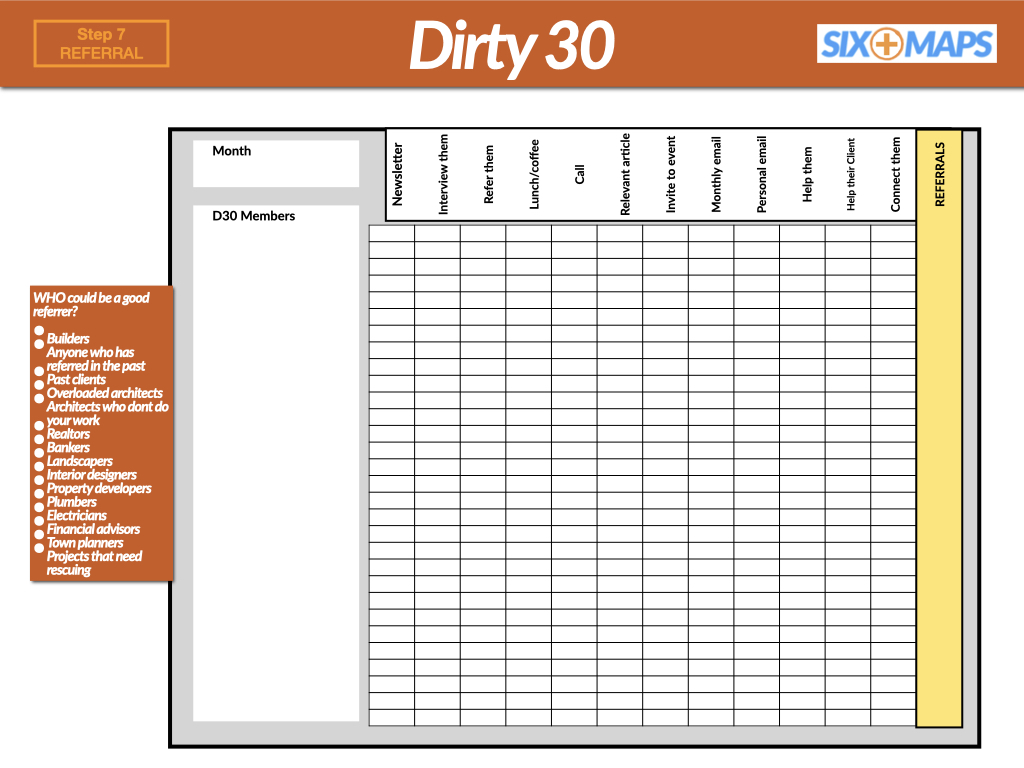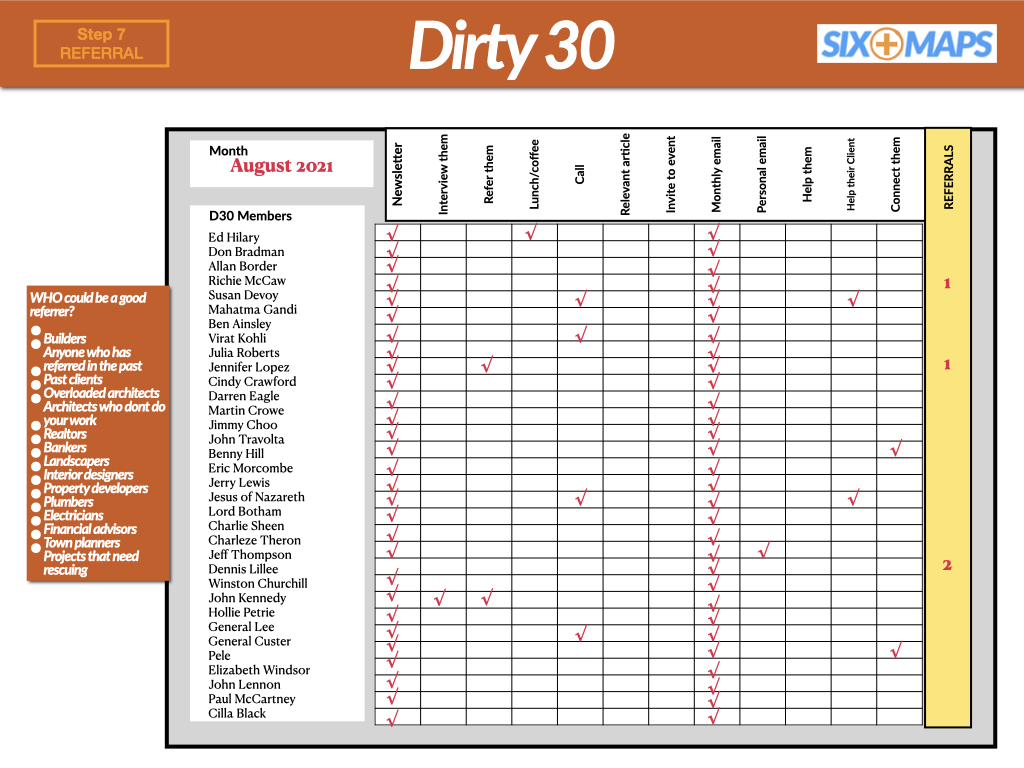CLICK HERE for Video Transcript
Speaker 1: I've put a worksheet for you now about referrals. Step number seven, and it's for the dirty 30 strategy. Probably my favorite all-time strategy. Pretty simple. The strategy is fairly straight forward. As you'll know, it's about finding out who could or should be sending referrals to me. Then it's put in place a referral system to stay in touch with those people or get to know those people. We all know that we could be doing, getting a lot more referrals than we should be getting. This one chart will help you immeasurably. It's pretty simple. You fill it out each month, and here's an example of one filled out. These are my dirty 30 members. You can see it, Hillary down to Cilla Black. This is for the month of August. What we have is, it looks like with this one everybody gets a newsletter. Speaker 1: Oh, except Dennis Lilly didn't get one, by the look of it, and everybody gets a monthly email. Okay. Those are easy. Those are leverage-able. You produce one, you send it to all of them and then interview them. We have got an interview with John Kennedy. Oops. Interview with John Kennedy in August. That's great. That would've been a good interview. What really happened on the grass knoll? It looks like this month you've marked off that you referred John Kennedy to someone, so it was good. John would appreciate that, and that would sort of build up a bit of goodwill with John. It looks like you went to lunch with Ed Hillary. That's good. Other than that, not too many lunches. You've called up Susan Davoy, Virat Kohli. Jesus got a call from you and General Lee. So you had a chat with those four this month. Speaker 1: No one got sent a relevant article. Sometimes it's a good idea to, if you see an article about mountain climbing or something like that, you might send it to Ed Hillary and say, "Hey Ed, I saw this article about mountain climbing. Thought you might like it." It's a good way just to stay in touch and just add some value sometimes. If you're talking with any of these people, John Travolta about brand and image or something, and you read a good article, you might photocopy it and send it to John and saying, "Hey, just sort of say article. Following up, we had a conversation about your brand, John, and the site kind of summed it up." It's good to send a relevant article every now and again, just, you'll be able to stay in touch. Invite to event. There was no events in August. Everybody got an email. Speaker 1: It looks like just Jeff Thompson got a personal email this month. You could do a little bit more there. Help them. Okay. This is a good one where the best way to get to know people is actually provide value to them. If there's any way that you can help anyone on this list. This is your list of potential referrers, so you want to be helping them any way you can, because you brought up that reciprocity. If you make yourself valuable and useful, then they're going to look to be valuable and useful for you. Given that these people are people you've identified as potential referrers, then you want to build up your emotional bank account with them. Maybe you can help their clients. In this case it looks like you helped one of Susan Davoy's clients out. It was very nice of you. She'll be grateful for that. Speaker 1: Also, looks like Jesus had a client helped out as well. Maybe you helped. I'm not sure what you would have done for Jesus, but I'm sure he'd appreciate it. Then finally, connect them. Okay. This is where sometimes you can connect people to other people. We've connected, it looks like you've connected Benny Hill and Pele. That's often an introduction to say, "Hey, Benny, I know you're into balls. Pele is also into balls. I think you two should connect and you might be able to help each other out in some way." Pele and Benny Hill got connected, and look, everyone wants to be connected. If there's a reason for the connection, then it makes you kind of the center of the universe. It looks like we got referrals from, Richie McCall gave us one. Jennifer Lopez. Speaker 1: That was good. And two from Dennis Lilly. That was pretty good. We didn't do much with Dennis Lilly, but he's certainly someone with keeping on this list and maybe we look to help him out in some way next month. Sometimes this is, it's a kind of a common sense thing. This whole getting in touch with a dirty 30, staying in touch with them and being as useful as you can. Not just asking for referrals, but actually being of value. How can I be a value? There are other things you could do. These are just my suggestions, but having a tracking sheet like this allows you to see how much you actually are doing to help and add value to your dirty 30 and stay top of mind with them. Because if you're top of mind and they see you as someone valuable and useful and with ways how you can help their client, maybe you're spelling out in your newsletter and your emails examples of how you're helping people out. Speaker 1: Then it's a good chance they may refer some of their clients to you, because you're top of mind and they actually know the value you add. So really useful sheet this, and you need one for each month. It needs to be on the wall where you can see it. Okay. The power of this thing is not by knowing it, not by having it on your computer somewhere, but by printing it out and putting it on your wall and filling it out each month. Whatever you focus on improves. So if you focus on this, I guarantee you'll get more referrals from your dirty 30. All right. Enjoy. |
Dirty 30 Worksheet

Dirty 30 Example

TRANSCRIPT
Transcript preparation is in progress.
